Problem 67 in Chapter 2 introduced a model for HIV infection. If retroviral drugs, RTIs and PIs
Question:
Problem 67 in Chapter 2 introduced a model for HIV infection. If retroviral drugs, RTIs and PIs as discussed in Problem22 in Chapter 1, are used, the model is modified as follows (Craig, 2004):
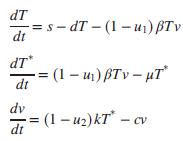
where 0 ≤ u1 ≤ 1, 0 ≤ u2 ≤ 1 represent the effectiveness of the RTI and PI medication, respectively.
a. Obtain a state-space representation of the HIV/AIDS model by linearizing the equations about the
![]()
equilibrium with u10 = u20 = 0. This equilibrium represents the asymptomatic HIV-infected patient. Note that each one of the above equations is of the form ẋi = fi(xi; u1; u2); i = 1; 2; 3.
b. If Matrices A and B are given by
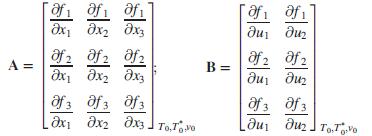
and we are interested in the number of free HIV viruses as the system’s output,

c. Typical parameter values and descriptions for the HIV/AIDS model are shown in the following table. Substitute the values from the table into your model and write as
ẋ = Ax + Bu
y = Cx
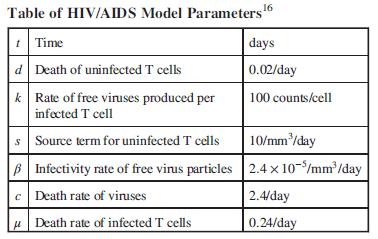
Data From Problem 67 in Chapter 2:
HIV inflicts its damage by infecting healthy CD4 + T cells (a type of white blood cell) that are necessary to fight infection. As the virus embeds in a T cell and the immune system produces more of these cells to fight the infection, the virus propagates in an opportunistic fashion. As we now develop a simple HIV model, refer to Figure P2.39. Normally T cells are produced at a rate s and die at a rate d. The HIV virus is present in the bloodstream in the infected individual. These viruses in the bloodstream, called free viruses, infect healthy T cells at a rate β. Also, the viruses reproduce through the T cell multiplication process or otherwise at a rate k. Free viruses die at a rate c. Infected T cells die at a rate μ.
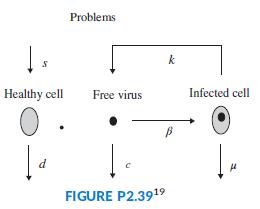
simple mathematical model that illustrates these interactions is given by the following equations (Craig, 2004):
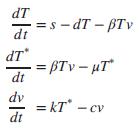
where
T = number of healthy T cells
T* = number of infected T cells
v = number of free viruses
a. The system is nonlinear; thus linearization is necessary to find transfer functions as you will do in subsequent chapters. The nonlinear nature of this model can be seen from the above equations. Determine which of these equations are linear, which are nonlinear, and explain why.
b. The system has two equilibrium points. Show that these are given by

Data From Problem22 in Chapter 1:
As of 2012, the number of people living worldwide with Human Immunodeficiency Virus/Acquired Immune Deficiency Syndrome (HIV/ AIDS) was estimated at 35 million, with 2.3 million new infections per year and 1.6 million deaths due to the disease (UNAIDS, 2013). Currently there is no known cure for the disease, and HIV cannot be completely eliminated in an infected individual. Drug combinations can be used to maintain the virus numbers at low levels, which helps prevent AIDS from developing. A common treatment for HIV is the administration of two types of drugs: reverse transcriptase inhibitors (RTIs) and protease inhibitors (PIs). The amount in which each of these drugs is administered is varied according to the amount of HIV viruses in the body (Craig, 2004). Draw a block diagram of a feedback system designed to control the amount of HIV viruses in an infected person. The plant input variables are the amount of RTIs and PIs dispensed. Show blocks representing the controller, the system under control, and the transducers. Label the corresponding variables at the input and output of every block.
Step by Step Answer:






